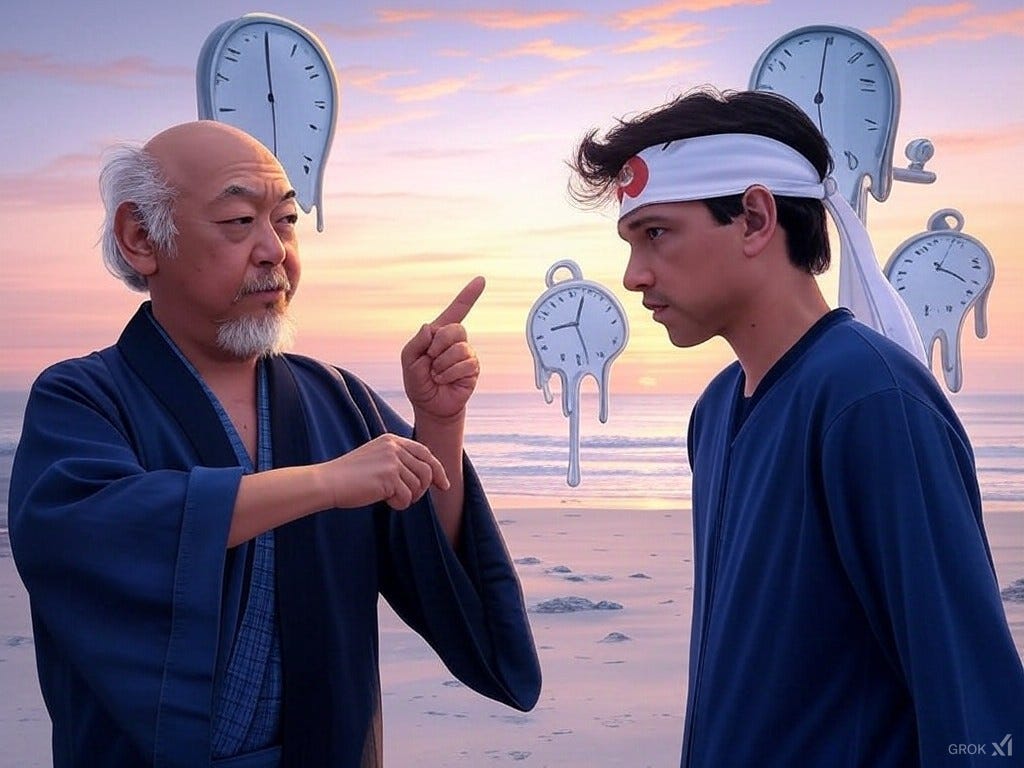DeepSeek's AI Dojo: Harnessing the Power of Reinforcement Learning
DeepSeek's AI model uses a similar transformer architecture as ChatGPT and Grok, but DeepSeek employs training techniques (such as RL) that enable it to cost-effectively outperform the competition.
The AI world has been buzzing about DeepSeek’s latest model, which has dazzled with its efficiency and remarkable performance. A key part of this success story lies in their strategic use of Reinforcement Learning (RL) as a fine-tuning technique. Let's explore this through a reimagined version of "The Karate Kid."
DeepSeek's Training Regimen:
The Groundwork: DeepSeek starts by "reading" the equivalent of all the world's martial arts texts. This represents the pre-training phase where the model absorbs a vast corpus of text, learning the breadth and depth of language from the internet, books, and beyond. This foundational knowledge is akin to Daniel LaRusso reading every book on martial arts in existence, making him theoretically the most knowledgeable fighter on paper.
Fine-Tuning with RL: After this extensive pre-training, DeepSeek employs RL to refine the model's capabilities. This phase is not about learning new concepts from scratch but about optimizing and adapting what's already known:
Efficiency in Action: DeepSeek uses RL to fine-tune the model, which means making targeted adjustments to enhance reasoning, accuracy, or alignment with human preferences, much like cleaning up a fighter's technique for real-world application.
Techniques in DeepSeek:
Group Relative Policy Optimization (GRPO): Similar to Mr. Miyagi's personalized training methods, GRPO in DeepSeek helps in optimizing the model's policy for better reasoning outcomes.
Chain of Thought (CoT): This technique encourages the model to think step-by-step, like Mr. Miyagi teaching Daniel the sequence of movements in a fight.
Reimagining The Karate Kid for RL:
Daniel, The Ultimate Scholar: Daniel doesn't just skim a single book but engulfs all knowledge on martial arts. He's the epitome of book learning, understanding every aspect from every angle. This is the LLM's pre-training, where it learns all possible language patterns.
Mr. Miyagi - The RL Coach: When Daniel meets Mr. Miyagi, the real learning begins. Mr. Miyagi, as RL, doesn't teach Daniel new martial arts but refines what he knows:
Wax On, Wax Off: These repetitive tasks are RL's way of providing feedback. Mr. Miyagi praises Daniel for correct moves (reward) and critiques or shows him again when he errs (penalty). This feedback loop is essential for fine-tuning:
Immediate Feedback: During training, Mr. Miyagi can instantly correct Daniel, much like RL can tweak model weights based on immediate output quality.
Real-World Application: The feedback is grounded in practical scenarios, ensuring Daniel's (or the model's) knowledge translates into effective action.
Tournaments - Inference: In competitions, there's no coaching. Mr. Miyagi observes Daniel's performance, noting what works and what doesn't. This is like when the DeepSeek model is in use, providing answers or generating text without intervention.
Post-Tournament Feedback: After the event, Mr. Miyagi uses this observation to tweak Daniel's training, similar to how RL fine-tuning might occur after collecting feedback on the model's performance during real-world use.
Conclusion: DeepSeek's use of RL for fine-tuning mirrors Mr. Miyagi's teachings in our reimagined "Karate Kid." It's not about imparting new knowledge but refining and adapting what's already learned for optimal performance. The model, like Daniel, benefits from this practical feedback to become not just knowledgeable but effective in real-world scenarios.
Final Thoughts: Just as Daniel learned to apply his book knowledge under Mr. Miyagi's guidance, DeepSeek's approach with RL ensures its AI model can translate vast theoretical understanding into practical, efficient, and high-performing applications. It's an elegant dance between absorbing the world's knowledge and mastering its application.



